 Publishing Director Sarah Lavelle Editor Stacey Cleworth Editorial Assistant Sofie Shearman Art Direction and Design Emily Lapworth Photographer Sam Folan Food Stylist Katie Marshall Props Stylist Agathe Gits Head of Production Stephen Lang Production Controller Sabeena Atchia Published in 2022 by Quadrille an imprint of Hardie Grant Publishing Quadrille 5254 Southwark Street London SE1 1UN quadrille.com All rights reserved. No part of this publication may be reproduced, stored in a retrieval system or transmitted in any form by any means, electronic, mechanical, photocopying, recording or otherwise, without the prior written permission of the publishers and copyright holders. The moral rights of the author have been asserted. Cataloguing in Publication Data: a catalogue record for this book is available from the British Library. Text Kwoklyn Wan 2022 Photography Sam Folan 2022 Design Quadrille 2022 eISBN 9781787137424
Publishing Director Sarah Lavelle Editor Stacey Cleworth Editorial Assistant Sofie Shearman Art Direction and Design Emily Lapworth Photographer Sam Folan Food Stylist Katie Marshall Props Stylist Agathe Gits Head of Production Stephen Lang Production Controller Sabeena Atchia Published in 2022 by Quadrille an imprint of Hardie Grant Publishing Quadrille 5254 Southwark Street London SE1 1UN quadrille.com All rights reserved. No part of this publication may be reproduced, stored in a retrieval system or transmitted in any form by any means, electronic, mechanical, photocopying, recording or otherwise, without the prior written permission of the publishers and copyright holders. The moral rights of the author have been asserted. Cataloguing in Publication Data: a catalogue record for this book is available from the British Library. Text Kwoklyn Wan 2022 Photography Sam Folan 2022 Design Quadrille 2022 eISBN 9781787137424
As I began researching express Chinese recipes I stumbled upon my familys restaurant archives and uncovered some amazingratro dishes that had once graced the menu in my grandads restaurant back in the sixties and seventies. I also took plenty of inspiration from dishes that members of my extended family were cooking on a day-to-day basis, as these were all super-easy and very, VERY quick to cook while never sacrificing flavour in the pursuit of speed.
Unlike the kitchen in a busy takeout or restaurant, a home kitchen should be a place of calm where you can enjoy the time you take preparing your ingredients, a place where you can sing along to your favourite tunes as you dance them into the wok and find your state of zen as you elevate finished dishes to your serving plate to the awe of your family and guests Reality check! Between juggling fulltime jobs, busy family schedules, pets, fitness and household chores, most of us are lucky if we find time midweek to boil some dried noodles and toss in a shop-bought sauce. Sure, the weekend can be a sacred time when you enjoy preparing banquet-style feasts, but that doesnt mean your taste buds have to go on a five-day flavour fast! This book is going to show you just how easy it is to get your Chinese takeout fix faster than popping a ready meal in the microwave. All the flavour, none of the nasties and barely a dent in your busy day; Ive got you covered from breakfast till supper with soups and snacks that will have everyone drooling, tips and tricks on getting the best out of a selection on ready-prepared and cooked ingredients, and simple fail-safe flavour combinations that can be used time and again with your meat, fish or veg of choice. Give them a try and always remember this: the recipe is your guide, but your own taste is key to creating truly mouth-watering dishes, so always taste, season and taste again! I would love to hear about the recipes youve been trying and you can watch me cooking more dishes, as well as keeping up to date with my food adventures at: www.kwoklynwan.com. 


Tenderizing/Velveting
Although the recipes in this book are all about speed, Ive included this technique because its recommended (but not essential) if youve got a bit of time. If youve ever wondered why meat or fish served in a Chinese takeaway or restaurant is so tender and juicy, velveting is the reason.
This marinating technique makes it harder for the proteins on the surface to bond, therefore keeping it tender and juicier during cooking. To marinate 350600g (12oz21oz) meat or fish you will need: 1 tbsp Chinese rice wine (Shaoxing wine), or use water 1 tbsp cornflour (cornstarch) 1 tbsp dark soy sauce 1 tbsp light soy sauce 1 tsp bicarbonate of soda (baking soda) Put all the ingredients into a large bowl along with the sliced meat, fish or king prawns (jumbo shrimp). Using your hands, mix everything together for around 3045 seconds; there should be no liquid left sitting in the bottom of the bowl by the time youve finished mixing. Cover the bowl and set aside for ideally 2 hours before cooking.
Blanching
Blanching, or partially cooking some of the larger ingredients, usually vegetables, before tossing them into your wok will save time and also ensure they are tender and cooked through. This method also ensures that the other ingredients are not overcooked, as the pre-blanched ingredients need less time in the wok.
Simply plunge the vegetables into boiling water for a brief time and then drain.
Shallow-frying
This method is used in many restaurants and takeaways around the world to cook pieces of meat or vegetables until crisp before adding them to a rich sauce. You generally need about 250ml (1 cup) of a neutral oil, added to a hot wok so that the food cooks quickly and evenly.
Stir-frying
The key to a great stir-fry is the size of your ingredients; this cooking method is very quick, so you need to make sure your ingredients, whether raw or pre-cooked, are all bite-sized and approximately the same size as each other to result in even cooking. Simply toss your ingredients into the wok with a little oil, add your seasoning and within mere minutes you will have a delicious dish ready for serving.
Thickening
Chinese cuisine is well known for its velvety sauces that cling to each ingredient as they spill onto your plate.
Thickening
Chinese cuisine is well known for its velvety sauces that cling to each ingredient as they spill onto your plate.
Creating a rich, smooth sauce isnt as hard as it may seem; simply adding a thickening agent during the cooking process will achieve this. For me, the thickening agent of choice has always been cornflour, added into marinades or sauce mixes, or even towards the very end of the cooking process, mixed with a little bit of water to add a final touch of velvet to a dish.
Chinese food is traditionally categorized into five flavours:
Salty,
Spicy,
Sour,
Sweet and
Bitter, with a sixth taste more recently coming to the fore,
Umami. Your store cupboard needs to provide you with these elements to enable you to create not just tasty food but outstanding dishes that tickle each individual taste bud. Youll find most of these ingredients in larger supermarkets, Asian supermarkets or online.
Oil
There are a multitude of oils to choose from, including vegetable, coconut, groundnut (peanut), sunflower, rapeseed (canola) and olive.
For Chinese cooking, the oil you choose needs to be able to be used for stir-frying but should also not deteriorate or lose power (as my dad would say) when used to shallow or deep-fry. For this reason, I mostly use vegetable, sunflower or groundnut. A note on used oil: Shallow- or deep-frying are excellent when youre against the clock, but they do require the use of more oil than a quick stir-fry. To save wastage, once your used oil has completely cooled, use a fine sieve to remove any debris and decant the oil into a bottle or jar to be used again. In the restaurants and takeaways Ive worked, we would use the oil three or four times before discarding it completely.
Next page

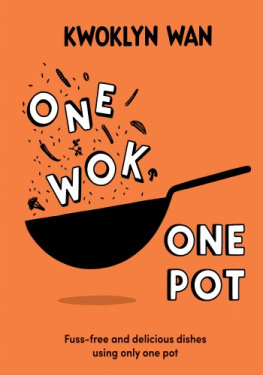
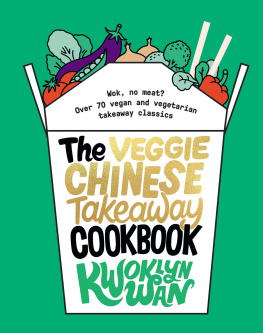

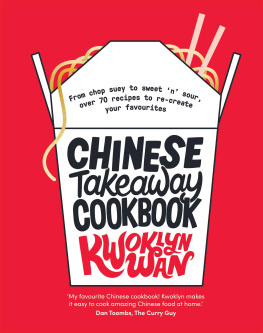
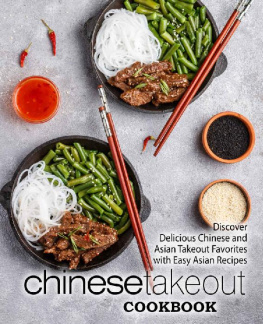
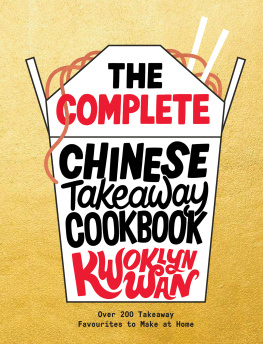
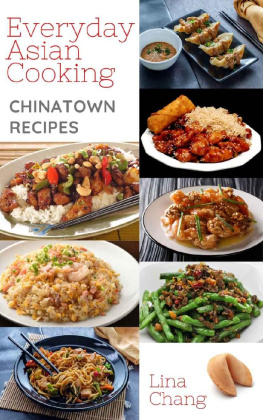
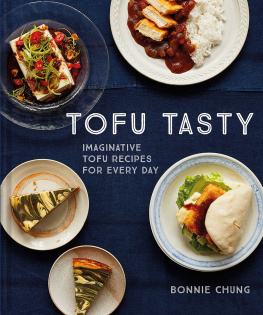
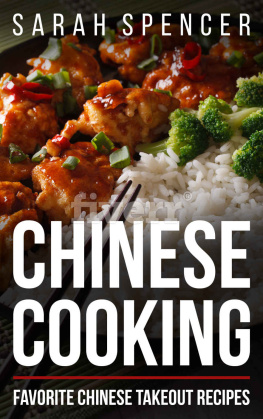
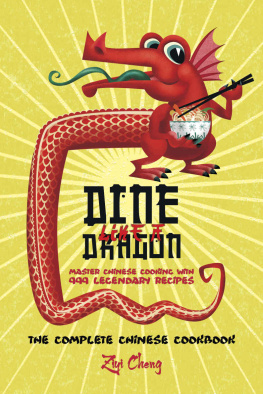
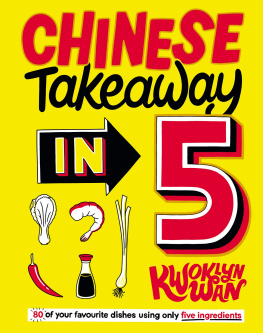

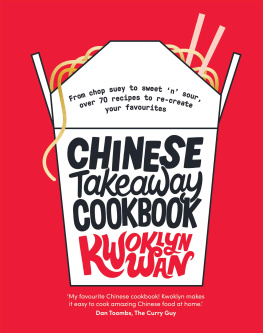
 Publishing Director Sarah Lavelle Editor Stacey Cleworth Editorial Assistant Sofie Shearman Art Direction and Design Emily Lapworth Photographer Sam Folan Food Stylist Katie Marshall Props Stylist Agathe Gits Head of Production Stephen Lang Production Controller Sabeena Atchia Published in 2022 by Quadrille an imprint of Hardie Grant Publishing Quadrille 5254 Southwark Street London SE1 1UN quadrille.com All rights reserved. No part of this publication may be reproduced, stored in a retrieval system or transmitted in any form by any means, electronic, mechanical, photocopying, recording or otherwise, without the prior written permission of the publishers and copyright holders. The moral rights of the author have been asserted. Cataloguing in Publication Data: a catalogue record for this book is available from the British Library. Text Kwoklyn Wan 2022 Photography Sam Folan 2022 Design Quadrille 2022 eISBN 9781787137424
Publishing Director Sarah Lavelle Editor Stacey Cleworth Editorial Assistant Sofie Shearman Art Direction and Design Emily Lapworth Photographer Sam Folan Food Stylist Katie Marshall Props Stylist Agathe Gits Head of Production Stephen Lang Production Controller Sabeena Atchia Published in 2022 by Quadrille an imprint of Hardie Grant Publishing Quadrille 5254 Southwark Street London SE1 1UN quadrille.com All rights reserved. No part of this publication may be reproduced, stored in a retrieval system or transmitted in any form by any means, electronic, mechanical, photocopying, recording or otherwise, without the prior written permission of the publishers and copyright holders. The moral rights of the author have been asserted. Cataloguing in Publication Data: a catalogue record for this book is available from the British Library. Text Kwoklyn Wan 2022 Photography Sam Folan 2022 Design Quadrille 2022 eISBN 9781787137424

